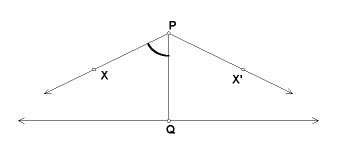
Theorem (Greenberg, p. 196): In hyperbolic geometry, for every line m and every point P not on m, let Q be the foot of the perpendicular from P to m. Then there are two unique nonopposite rays PX and PX ' on opposite sides of line PQ that do not meet m and have the property that a ray emanating from P meets m if and only if it is between ray PX and ray PX '. Moreover, these limiting rays are situated symmetrically about line PQ in the sense that angle XPQ and angle X'PQ are congruent.Either of the congruent angles XPQ and X'PQ is called the angle of parallelism determined by P and Q:

Note that although the "Givens" in the theorem are a point P and a line m, if we are given points P and Q instead, we can define m as the line through Q that is perpendicular to segment PQ. In this way the phrase, "the angle of parallelism determined by P and Q," is well-defined.
An exercise that will help students understand this definition is to have them illustrate the theorem in one of the hyperbolic models:
Exercise:Solution:
- In Geometer's Sketchpad, open one of your hyperbolic models and plot two arbitrary points P and Q. Construct and measure the angle of parallelism determined by P and Q.
- What range of values can the measure of the angle of parallelism take? Explain how you can tell.
The Java Sketchpad figure below demonstrates possible construction steps for the angle of parallelism in the Klein model. Click on "Construction Steps," then click on each step in turn to see the construction: